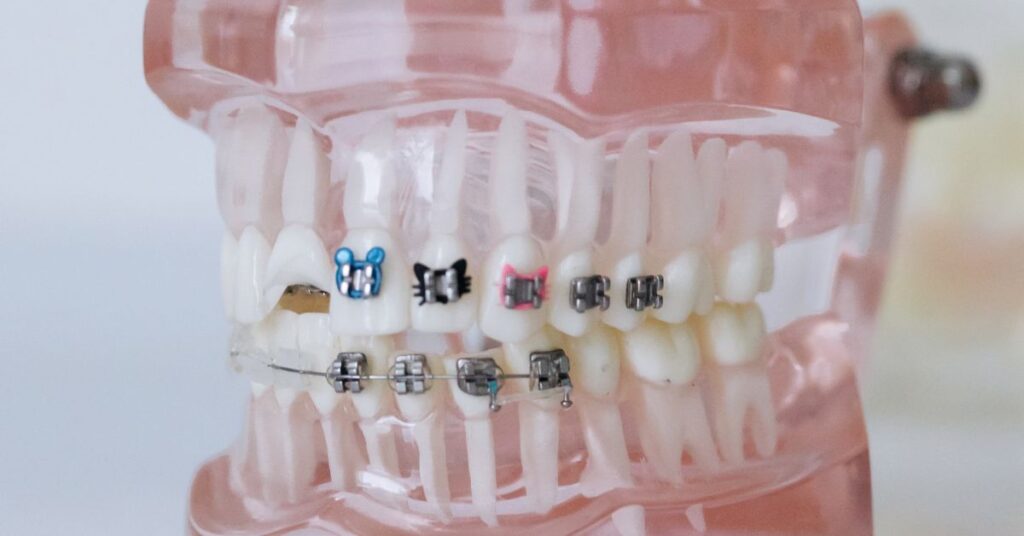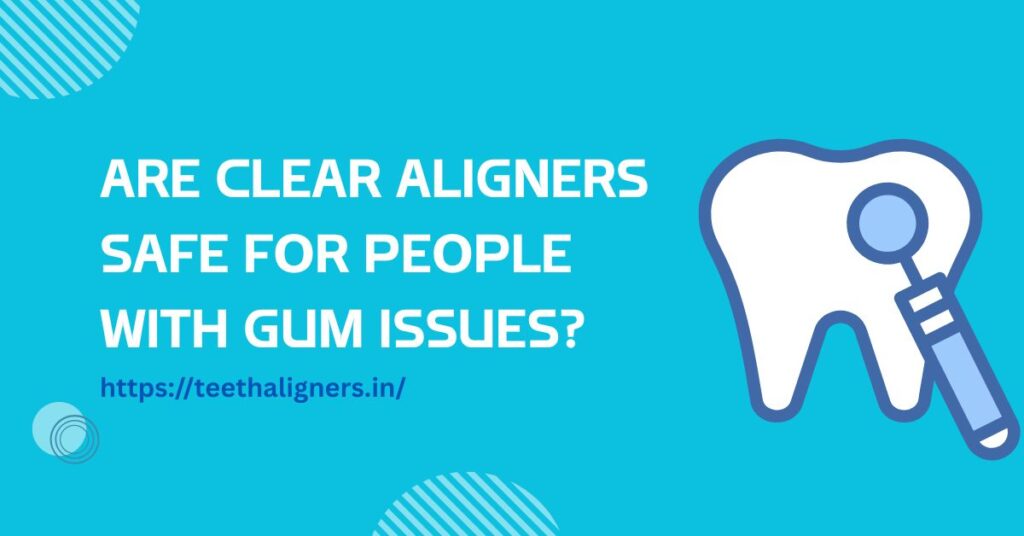Many people dream of a straighter smile, but if you already have gum problems, you may worry whether orthodontic treatment is safe. Gum health plays a huge role in supporting your teeth.
So it is natural to wonder if moving teeth could make things worse. This concern often arises when patients consider Clear Aligners, since they shift teeth gradually with removable trays.
The truth is that aligners can be safe for many patients with gum issues, but safety depends on the severity of the gum condition, the timing of treatment, and the care taken before and during the alignment process. To understand this better, let’s look closely at how gum health interacts with aligner treatment.
Table of Contents
ToggleUnderstanding Gum Issues and Their Impact on Oral Health
Gum disease is one of the most common oral health concerns worldwide. It usually begins with gingivitis, a mild stage where gums become red, swollen, and bleed easily during brushing.
If not treated in time, it can progress to periodontitis, a more advanced form that causes gum recession and even bone loss around the teeth. The main cause of gum problems is plaque, a sticky layer of bacteria that builds up on the teeth and gumline.
Without proper cleaning, plaque hardens into tartar, which irritates the gums and leads to infection. Poor oral hygiene is the most frequent cause, but lifestyle factors like smoking, stress, and an unhealthy diet also play a part.
Genetics can also make some people more prone to gum disease. With Invisible teeth aligners, gum health becomes even more important, since healthy supporting tissues are essential for stable and safe tooth movement.
Common signs of gum problems include red or puffy gums, bleeding when brushing or flossing, bad breath that does not go away, and in more serious cases, loose or shifting teeth.
These symptoms show that the supporting structures of the teeth are being weakened.Healthy gums are essential before starting any orthodontic treatment.
If gums are already inflamed or bone support is reduced, shifting teeth could increase mobility and make the condition worse. That is why dentists always recommend treating gum problems first before beginning alignment therapy.
What Are Clear Aligners and How Do They Work?
Clear Aligners are transparent, custom-made trays that fit tightly over the teeth. Each tray is designed to apply gentle pressure to specific teeth, gradually guiding them into a new position.
Patients switch to a new set of aligners every one to two weeks, with each stage moving the teeth closer to the planned alignment.
The biggest difference between aligners and traditional braces is removability. Braces use metal brackets and wires fixed to the teeth, which stay in place for the entire treatment period.
Aligners, on the other hand, can be removed while eating, brushing, and flossing. This makes them easier to clean and more comfortable for many people.
Because they are nearly invisible, aligners are also a more discreet option for adults and teenagers who want straight teeth without the noticeable look of braces.
While they work in a different way, the principle is the same: applying consistent pressure to shift teeth into a healthier and more balanced position.
Can People with Gum Issues Use Clear Aligners?
The short answer is yes, but with important conditions. People with mild gum disease, such as early gingivitis, may still be candidates for aligners. In fact, correcting misaligned teeth can help reduce uneven pressure on gums and improve oral hygiene over time.
For example, if teeth are crowded, it becomes harder to clean between them, which allows plaque and bacteria to grow. By straightening the teeth, aligners can make brushing and flossing more effective, lowering the chance of gum inflammation in the future.
However, people with moderate or severe gum disease must address their condition first. Moving teeth in an unhealthy foundation can increase the risk of tooth loss. Dentists often require gum therapy, such as scaling, root planing, or even periodontal surgery, before orthodontic treatment begins.
Benefits of Using Clear Aligners for Gum Health
One of the greatest advantages of aligners is that they can be removed. This makes brushing and flossing easier compared to fixed braces. With braces, food particles often get trapped between brackets and wires, which increases the risk of plaque buildup.
Aligners remove this challenge, giving patients with gum problems a cleaner and safer option.Another benefit is reduced irritation.
Metal brackets and wires can sometimes cause sores or irritate inflamed gums, while aligners are smooth and comfortable. By improving bite alignment, aligners also distribute chewing forces more evenly, lowering the stress placed on certain teeth and gums.
Risks and Concerns for Patients with Gum Issues
Despite these benefits, there are still risks. If gum disease is active, aligners can cause further problems by moving teeth in weakened bone structures. Patients may notice increased mobility or discomfort if treatment begins before gums are stabilized.
Another issue is irritation. Even though aligners are smooth, they can press on swollen gums, causing tenderness or discomfort. Patients with severe gum recession may also find that aligners fit poorly or do not provide proper support.
This is why professional supervision is critical. Without careful monitoring, gum health may decline, even if teeth alignment improves.
The Role of Dental Supervision in Treatment
No patient with gum issues should begin aligner treatment without a complete dental evaluation. Dentists and periodontists work together to assess gum health before prescribing aligners. They may recommend a deep cleaning or other periodontal treatment first.
During aligner use, follow-up visits are vital. These checkups allow the dentist to track not only tooth movement but also gum health.
If signs of inflammation return, adjustments can be made quickly.In areas like south delhi, patients often benefit from specialized clinics where orthodontists and gum experts collaborate.
This kind of teamwork gives patients confidence that both their teeth and gums are being cared for throughout treatment.Proper supervision makes aligners safer and helps ensure that the results last long after the trays are removed.
Best Practices for People with Gum Problems Using Clear Aligners
For patients with gum concerns, good daily habits are essential. Brushing twice a day with a soft-bristled brush, flossing carefully, and using an antibacterial rinse can help keep gums clean and healthy.
Cleaning the aligners themselves is equally important, since bacteria can collect on the trays and spread back into the mouth.Regular dental checkups should not be skipped.
People with a history of gum problems may need more frequent cleanings, sometimes every three to four months instead of the usual six. This extra care can prevent relapses during aligner treatment.
Healthy lifestyle choices also support gum recovery. Avoiding smoking, reducing sugary foods, eating a balanced diet, and drinking enough water all make a big difference. These habits create a healthier environment for both gums and teeth during orthodontic treatment.
When Should You Avoid Clear Aligners with Gum Issues?
There are certain cases where aligner treatment should be postponed. Patients with active gum infections should not start clear aligners until the infection is treated. Attempting to move teeth in inflamed gums can worsen the condition.
Severe periodontitis with bone loss is another red flag. In these cases, the support holding the teeth is already weakened, and tooth movement could make the problem worse. Advanced gum disease may require surgery or grafting before orthodontics becomes an option.
People with medical conditions like uncontrolled diabetes may also need to wait. Since diabetes can slow healing and increase infection risk, gum health must be stable before starting aligner therapy.
The general rule is simple: aligners should never be used until the gums are strong enough to handle the changes.
Patient Stories and Practical Insights
Real-life examples show how different gum conditions affect aligner treatment. Consider a patient with mild gingivitis who wanted straighter teeth. After a professional cleaning and improved home care, aligners were introduced.
Because of the removability of the trays, this patient was able to maintain excellent hygiene, and gum health improved alongside tooth alignment.In another case, a patient with advanced periodontitis could not start aligners right away.
First, gum surgery was needed to restore stability. Only after recovery could aligner treatment begin safely. This example shows why treatment plans must be personalized.
Clinics such as our clinic often manage patients with gum challenges by combining periodontal care with orthodontic planning. This kind of approach gives patients both healthier gums and straighter teeth in a way that is safe and effective.
Conclusion
Gum health and orthodontic treatment are closely connected. Aligners can be safe for people with gum issues, but only if the condition is managed properly before and during treatment.
Mild gum problems can often improve alongside aligner therapy, while severe conditions must be treated first to avoid risks.
With daily hygiene, regular dental visits, and professional supervision, patients can enjoy straighter teeth without damaging their gums.
For those considering treatment in south delhi or nearby areas, the first step should always be a thorough gum evaluation before beginning aligner use.
For safe and effective care, consulting experts like Teeth Aligners in India can provide both professional guidance and treatment that respects your gum health while helping you achieve the smile you want.


